Exploring the Deserted Village
The rain we had been expecting did not stop the three-hour walk to
the deserted village with our local specialist, Thomas McLoughlan. We
learned a lot about the region around Keel.
The construction of house roofs has been adjusted to the conditions of
this particular landscape. Sometimes, though not very often, heavy storms
occur - and roofs have been damaged in the past. As a result, a number
of houses have flat roofs, which cannot be swept away that easily. However,
one big disadvantage of them is that it is much more difficult to heat
the houses properly - especially if the roofs aren't done correctly.
In the past, houses were often built of uneven stones heaped upon each
other. Their façade would normally have a front door and two windows.
However, the houses of the deserted village only have a door and no windows
(on the eastern side, as the heavy weather normally comes from the west).
The average family would consist of about 14 people. Just imagine how
such a number of persons could live in a rather small house - covering
a ground area of perhaps 5 x 2 metres! There would also be a cow inside;
its dung was collected outside in order to fertilise the potato crops.
People slept in the loft. The roof was made of wood and covered with rushes;
so they did not need a chimney for the fireplace.
One acre of potatoes was enough to feed a complete family - even including
a pig. If the harvest failed, people had nothing to eat and would have
to starve.
In order to grow the potatoes, small trenches were dug into the ground
to form the ridges where the crops were placed and covered with the material
from the trenches. The ridges were directed from the feet of the mountains
towards the sea, so that the potatoes would keep dryer. These 'lazy beds'
were ideal for the boggy area - and the soft waves on the ground around
the village still show their former positions.
It is not recorded why Tur and Tur Riabhach were given up. Most people
believe that it was a gradual process; perhaps people moved gradually
when the potato crops failed. We can imagine that there were pressures
on the tenants when their landlords found that they could not pay the
rent.
When we passed the cemetery, we were told about the holy well devoted
to St. Coleman, which had existed in pre-Christian times before it was
integrated into the new religion. We also heard about one of many sea
tragedies which happened on the island. Three shepherds and their dog
were found dead on the opposite side of Slievemore. People believe that
they were following their sheep through the cliffs; they must have been
surprised by water rushing in. They are now buried together.
Thomas McLoughlin also mentioned the legend of St. Brigid. She wanted
to build a church in a village, but the local chieftain did not allow
her to build it on his ground. She repeated her request again and again.
At last the chieftain allowed her to use as much of his ground as she
could cover with her cloak St. Brigid spread her cloak out and it grew
bigger and bigger until it covered a substantial part of the chieftain's
area; and so she built the church. On his deathbed, he called her again.
In order to explain the meaning of the cross to him, she wove a cross
using rushes. Our whole group learned how to do such a cross, as they
are still being made in Ireland on St. Brigid's day in February.
During the walk we watched the singing birds, a fox, the swans on the
Keel lake, and, of course, a lot of sheep. Their number is about twice
as high as the number of the human inhabitants of Achill Island. Because
the soil is very wet, the ground is covered with rushes and yellow blooming
bushes with thorns. There is grass wherever the sheep are grazing - and
nearly no trees.
We returned in bright sunshine. By lunchtime, our clothes were dry again.
We were all overwhelmed by the changing views of the rocks and the clouds
hanging in them.
February 6th, 2001 - Painting O´Donnell
 Going
out there, passing breathtaking landscapes - Slievemoore Hill. A variety
of shades of brown and green - White spots for sheep, scattered around
- a huge lake on the left, reflecting the sky - pitch black, the mountain
behind it - gloomy clouds.
Going
out there, passing breathtaking landscapes - Slievemoore Hill. A variety
of shades of brown and green - White spots for sheep, scattered around
- a huge lake on the left, reflecting the sky - pitch black, the mountain
behind it - gloomy clouds.
Look out for red and blue.
Yawl Art Gallery. Joseph o`Dalaigh, here we are. Hello… a warm smile…
a look at us ( six different European, American people).
"Do we need a pocket watch today?" Laughing. I never take a
watch with me when I paint…it´s useless…forget about time,
schedule, etc. when you paint…relax.. be happy !!
"Yepeeh!" - that´s it - the most important thing is to
be happy !
Encouragement, acceptance of how and what you are at that moment. Just
look at that… Smell….Feel..Yes! Which mood are you in today
? Choose different colours for different moods.
Tea..scones…looking at the landscape..John , the gardener falls in
love with Mary from the States who is trying to track down her family
lines in Ireland.
Relax..Be happy.
A., M., B., G., B., and G. O´Donnell leave Joseph O´Dalaigh.
Relaxed. Happy.
Yepeeh!!
Gesa Lüdemann
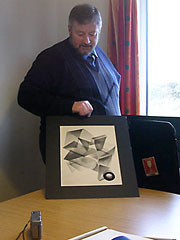
<< "This is not what we want to do"
-Sean warning the photo group not to try to be too elaborate...
Jutta and Hans-Hermann
look confused (and we
really were at the time!) >>
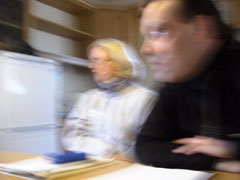
Inspired by Sean's landscape
In front of us was a camera but, "Don't let this technical thing
be an obstacle between you and your creative imagination" said Sean..
"You should go out with the camera looking for your own perspective
and I guess you'll find something to connect to Brian O' Donnell's story.
It would be perfect to combine your photos with your words." Then
we went out into the beautiful, sunny landscape of Keem Bay to take our
photographs that we would make into pictures. We had another friendly
and knowledgable guy from Keel with us - the other Sean. On the way back
we stopped at the mountain lake where the wonderful water mirrored the
sorrounding rocks and brown fields.
Hans-Hermann Groppe
Anthropology
We participated in a guided tour, led by Thomas M., to the deserted village, Toir Reabuach, which is close to Keel.
On the way there we got to see the typical turf-banks dug by the villagers and learned about the spraypaint marking of the sheep that graze around the village.
At the graveyard we say the holy well belonging to St. Coleman, though Tom couldn't tell us exactly what St. Coleman was the patron saint of..
Some of the graves in the old part of the graveyard dated back several thousand years. We also saw the remains of an old church from the early Christianity era, with the typical architectural feature of openings facing east-west.
Then we finally reached the remains of the deserted village. It consists of about 80 houses, some better preserved than others, along the side of Mt. Slievemore. Tom also pointed out the lazy beds used for growing potato, these had created a landscape full of waves. Potatoes were the most important crop for the people at that time. One acre could feed an entire family along with their pigs, chickens and sheep for a whole year.
The village is thought to have consisted of around 1000 people with about 14 people in each family. The houses were quite small but since the people spent most of the day working outside this didn't matter. Most of the year they also kept their cows inside the houses at night , mostly for the warmth that the cows generated.
This village was different from many other villages of that time in that the villagers stayed in the village the whole year round, they didn't move away for the summer with the cattle.
Today nobody is quite certain why all the villagers decided to leave, though there are a few qualified guesses. For example that the famine forced people to leave Toir Reabuach as well as so many other villagers. Or maybe the reason was that people were evicted from their homes when they weren't able to pay rent.
Creative writing
Today we had our first creative writing workshop meeting in cottage 3 starting at 10 am. Because of having gone to bed very late last night, I slept too long and missed breakfast. So I was really in a hurry but I was still on time.
As none of our stories so far have included much description of their settings (except for Cologne Cathedral), Alexandra asked us to write some descriptions of settings which we can work into our stories later.
They were quite different. Ulrike described cattle, Henrike gave her impressions of the sea, Malin wrote about the deserted village and I explained my mood when I saw the sky at night and the stars above Achill Island through the eyes of my character.
Later we went on to write not so creative things. We made a short summary of all the stories and put them on a map Alexandra had designed.
Finally, we wrote down one list for each team of all their characters, giving a short description of their connection with Brian O'Donnell.
Now, anybody who wants to know anything about a story or a character can just visit cottage 3 and have a look at the window where we have taped up a poster with all the descriptions.
"Europe goes to school"
This was a busy day for me…Getting up in the morning to make breakfast and doing the shopping for the lunch and then of course there was the preparation of the lunch. In between I managed to join the Gaelic workshop were Thomas was telling us about the Irish history, the Celts and the Gaelic language etc.
I got in touch with the primary school teacher, Irene Patten, to arrange a time and day for us to visit the school. After lunch the weather cleared up and the whole world was warm and lovely…so I took a walk on the beach and thought about what we had been told in the morning.
The second day of the workshop we were placed in one of the cottages with a view over the stormy sea. We were all happy to be indoors because it was pouring with rain (again).
We started off by introducing the other group members to our own country's school systems and found that the differences between the German, Swedish, Portuguese and Colombian systems weren't that big. We also discussed differences and similarities in our social systems and discovered weaknesses, which we think need to be improved. Finally we talked a bit about equality, prejudices and cultural differences in general. Time passed very quickly and suddenly it was time to go back to the hostel to get ready for dinner.
We were all very pleased with the progress we have made in our workshop and the Monday evening had a very nice end to it…
Gaelic meets Runic
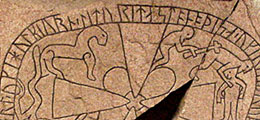 We
met in cottage five at 10 a.m. By considering parallels between different
cultures, we reached an understanding of how different languages are connected
to each other. Tom Johnston introduced us to the Gaelic language with a
very interesting story of how people from different parts of Europe came
to Ireland at various times and how that affected the development of the
Gaelic language.
We
met in cottage five at 10 a.m. By considering parallels between different
cultures, we reached an understanding of how different languages are connected
to each other. Tom Johnston introduced us to the Gaelic language with a
very interesting story of how people from different parts of Europe came
to Ireland at various times and how that affected the development of the
Gaelic language.After that I introduced everyone to the runic alphabet and the meaning of the signs. We draw parallels between Gaelic and runes, since a lot of Vikings travelled to Ireland, and even today there are a lot of signs of Vikings settlement here. Even some words in Gaelic, Swedish and German are quite similar.
As a finale to the day's workshop, Tom gave us a ride in his car and we visited the deserted village and the IT Centre. We got a lot of information about both places and what they meant to the inhabitants of Achill Island.
Instrumental Music Workshop
We are sitting in a nice and warm cottage on Achill Island. Just now, the floor is covered with our musical scores, candles are burning around us, chocolate and tea are on the table for our visitors. Luckily we met five young musicians from Achill Island at our get-together yesterday evening. They are Maria, Sarah and some members of the younger generation, whom we are really proud of: Shuna (14), Bill (12) and Richard (10). They all brought their instruments along so that we can start to play immediately.
First Maria and Sarah tell us about the traditional Irish instruments they usually play and then both perform a few pieces for us. The sureness and brilliance with which they play the tin whistle, the concertina and the banjo are impressive (I think it is worth mentioning that Sarah´s concertina is approximately 7 years old!!) It is interesting to hear such a mixture of traditional instruments.
Then we encouraged our young people to play the fiddle, tin whistle and the concert flute. They play brilliantly, too. This way we get to know that even the youngest inhabitants of Achill Island know a lot of Irish Music and we get the impression that everyone on the island is born with traditional music in their blood.
We enjoyed our afternoon to such an extent that we all completely lost track of time. Sadly enough the afternoon had to end but we are really looking forward to meeting them again on Tuesday afternoon.
by Silvia Klewer
Melting Pot
Monday night spontaneously became pub night, probably mainly because of the mood that was set by the presentations after dinner. While the mood was high the crowd headed for the "Village Inn". The teams mixed, people joked with each other while Ireland's national drink was sampled. As the groups became more relaxed "intercultural exchange" increased, so did the celebratory mood and the noise level. Pool games were won and lost, and people exchanged phrases and songs in their native languages with their newfound friends from other countries.
All in all, the evening was a good investment in togetherness and we went to bed with a good feeling.
A master of the sea entered the room when we were brainstorming about our sessions for the whole week. Without much ado, he started scribbling and sketching on the board. Our eyes were glued to his drawings and our ears were widely opened listening to his stories, experiences and skills. Getting to know the techniques and how it developed through times made us realized how man´s skills and nature worked together. Catching lobsters, salmon and sharks needs a lot of efforts and clever techniques but once you get to learn it, it will be easy later on.
Aside from that, the present problems of the island in fishing were also discussed. It was a wonderful start for all of us who signed up for the Your sea- Our sea Workshop.
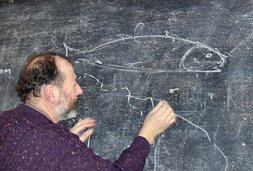 As the session came to its end, the sun came out from the clouds which encouraged
us to go out for a walk along the seashore.
As the session came to its end, the sun came out from the clouds which encouraged
us to go out for a walk along the seashore.
It is true what he said:
"There´s a great freedom in the open water"
-John Gallagher-
written by Ces
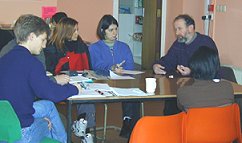 The
Our Sea/Your Sea workshop started on Monday morning 10.00 a.m.
All the participants were full of enthusiasm, energy and ideas. There
were discussions about everything - the agenda, assignment of tasks, the
Friday presentation. Then John Gallagher came, and told us stories about
the fishing of lobsters, sharks and salmon. He drew on the blackboard
the different fish, explaining the difference between them.He shared with
us his knowledge about the various ships and about the history of Achill
Island, and Ireland as a whole. Unfortunately, he had to leave after one
and a half hours, after answering some of our questions. He also told
us that he can only be away from the sea for a few hours! Afterwards we
all decided to walk to the sea and to look at the thing we had been talking
about the whole morning. The view of the sea and the cliffs around was
unforgettable.
The
Our Sea/Your Sea workshop started on Monday morning 10.00 a.m.
All the participants were full of enthusiasm, energy and ideas. There
were discussions about everything - the agenda, assignment of tasks, the
Friday presentation. Then John Gallagher came, and told us stories about
the fishing of lobsters, sharks and salmon. He drew on the blackboard
the different fish, explaining the difference between them.He shared with
us his knowledge about the various ships and about the history of Achill
Island, and Ireland as a whole. Unfortunately, he had to leave after one
and a half hours, after answering some of our questions. He also told
us that he can only be away from the sea for a few hours! Afterwards we
all decided to walk to the sea and to look at the thing we had been talking
about the whole morning. The view of the sea and the cliffs around was
unforgettable.
Singing Workshop
We met in Cottage 3 with cookies and tea and started planning our program for Friday night's grand finale! We tried out different songs from our collection and found that sadly some didn't match our voices. We then looked into the Achill Songbook especially collected for this trip by the music group and found some other suitable songs. We decided on two a-capella pieces. For three or four other songs we would need the help of the music workshop people. We decided to contact them on Tuesday.
We then started writing new lyrics for old songs, thus adapting them to the landscape and the people of Achill Island.
Some of the members of our singing group even gave a small performance in the local pub that night.

